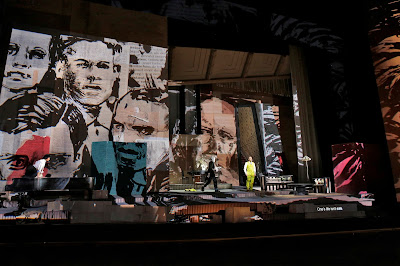Elizabeth – After seeing William Kentridge’s new production of Lulu on opening night at the Met, I realized I needed to see it a second time in order to fully take in the opera. So we went again (thank you Met Rush lottery!) this past Saturday for one of the final performances. This production has so much going on.
 The opera opens with a carnival barker inviting you in as pen and ink drawings of animals are projected behind him; yet soon other inanimate objects like gas masks start appearing. It’s disorienting, especially with the “12 tone” atonal music. You’re never quite able to sit back and relax into the music of the opera, but I think that’s one of the points. You’re supposed to be on edge and feel a bit off kilter and like you don’t know what will come next.
The opera opens with a carnival barker inviting you in as pen and ink drawings of animals are projected behind him; yet soon other inanimate objects like gas masks start appearing. It’s disorienting, especially with the “12 tone” atonal music. You’re never quite able to sit back and relax into the music of the opera, but I think that’s one of the points. You’re supposed to be on edge and feel a bit off kilter and like you don’t know what will come next.
 Throughout the opera projections onto the back wall of the stage were constantly and quickly changing–from pen and ink drawings of women, clips from newspapers, a stage itself, even occasionally turning into Rorschach ink blots. Later in Act 2, movies projected onto the wall told most of the plot. The walls themselves were shifting panels that were mostly tan and had German Expressionistic art painted on them. And that was just the background. Onstage were lightly sketched rooms often with a piece or two of furniture that took up only small parts of the stage. The rest of the stage was either blank or had action going on in the form of a silent woman who sometimes donned the same face mask as Lulu and alternately danced or sat at a piano and a male counterpart who assisted silently with props the singers needed.
Throughout the opera projections onto the back wall of the stage were constantly and quickly changing–from pen and ink drawings of women, clips from newspapers, a stage itself, even occasionally turning into Rorschach ink blots. Later in Act 2, movies projected onto the wall told most of the plot. The walls themselves were shifting panels that were mostly tan and had German Expressionistic art painted on them. And that was just the background. Onstage were lightly sketched rooms often with a piece or two of furniture that took up only small parts of the stage. The rest of the stage was either blank or had action going on in the form of a silent woman who sometimes donned the same face mask as Lulu and alternately danced or sat at a piano and a male counterpart who assisted silently with props the singers needed.
 Shawn – I enjoyed William Kentridge’s production of The Nose two years ago so immensely, I basically built our season this year around his new production of Lulu. We then ended up rushing tickets to see Lulu a second time. I needed to in order to even begin to unravel the aesthetic density of it all. Two highly dense and evocative artistic endeavors are occurring simultaneously onstage. Berg’s opera itself and William Kentridge’s production of it. This is not a bad thing. This is what the Met should be doing, bringing in serious world class visual artists in an attempt to create challenging and thought provoking productions that linger far after the curtain has fallen. Think Parsifal, the aforementioned The Nose, Anthony Minghella’s Madama Butterfly; these all have moments that stick with me vividly to this day.
Shawn – I enjoyed William Kentridge’s production of The Nose two years ago so immensely, I basically built our season this year around his new production of Lulu. We then ended up rushing tickets to see Lulu a second time. I needed to in order to even begin to unravel the aesthetic density of it all. Two highly dense and evocative artistic endeavors are occurring simultaneously onstage. Berg’s opera itself and William Kentridge’s production of it. This is not a bad thing. This is what the Met should be doing, bringing in serious world class visual artists in an attempt to create challenging and thought provoking productions that linger far after the curtain has fallen. Think Parsifal, the aforementioned The Nose, Anthony Minghella’s Madama Butterfly; these all have moments that stick with me vividly to this day.
– Elizabeth Frayer & Shawn E Milnes
Related Links:
Wild Audiences, Roses and Spectacle: Il Trovatore and Turandot at the Metropolitan Opera
Runny Noses, Russian and Otherwise: The Nose at the Metropolitan Opera
A Womb in the Country: Ethel Smyth’s The Wrecker’s at Bard SummerScape






Leave a Reply